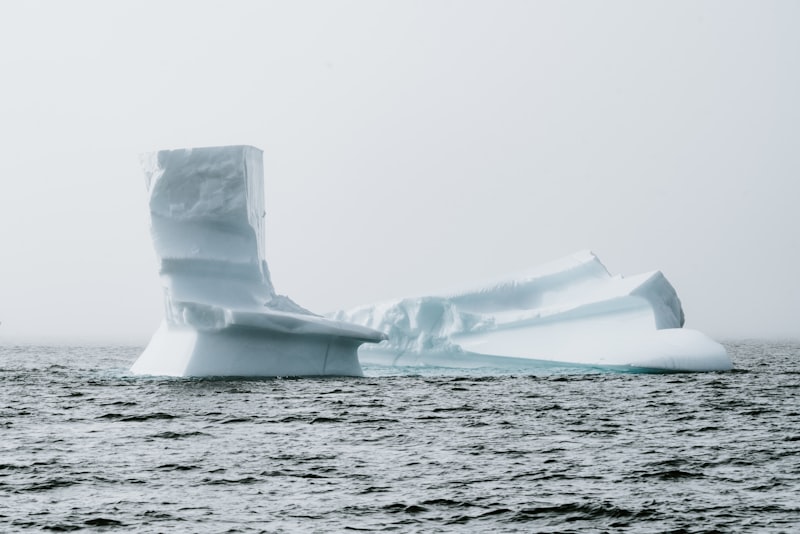Imagine a world where every plant, animal, and microbe is finely tuned to the cold, dry conditions. Arctic tundra species have evolved specialized genetic adaptations that allow them to withstand freezing temperatures, short growing seasons, and nutrient-poor soils. These adaptations are like a survival toolkit handed down through generations, enabling plants like Arctic willows and lichens to photosynthesize efficiently even in low light and extreme cold.
But it’s not just about surviving; it’s about thriving in a delicate balance. The genes of Arctic organisms also influence their interactions with each other and their surroundings. For instance, genetic diversity among herbivores like Arctic hares and lemmings can affect the entire ecosystem’s stability, influencing plant communities and even predators like Arctic foxes and snowy owls.
Researchers studying ecological genetics in Arctic tundra are like detectives unraveling a mystery. They use advanced DNA sequencing technologies to uncover the genetic codes that underpin these adaptations. By understanding these genetic blueprints, scientists can predict how species might respond to environmental changes such as climate warming or human disturbances.
In a way, Arctic tundra genetics teach us lessons in resilience and adaptation. They remind us of nature’s incredible capacity to innovate and survive against all odds. Each gene is a chapter in a story of evolutionary success, written over millennia in response to the challenges of this unforgiving environment.
Next time you imagine the Arctic tundra, think beyond its icy plains and snow-capped mountains. Think of the intricate genetic tapestry that supports life in one of the Earth’s last great wildernesses—a testament to nature’s ingenuity and the power of adaptation.
Unraveling the Secrets of Adaptation: Ecological Genetics in Arctic Tundra
In this frigid landscape, where temperatures plummet and daylight fluctuates drastically, life has found remarkable ways to not just survive, but to thrive. Species ranging from tiny mosses to majestic caribou have honed genetic adaptations over generations, allowing them to withstand freezing temperatures and exploit fleeting periods of growth.
One of the key adaptations observed is in the metabolic processes of Arctic plants. These hardy flora have evolved mechanisms to efficiently use limited nutrients and maximize photosynthesis during brief Arctic summers. Their genetic makeup enables them to store energy effectively, crucial for enduring long, dark winters.

Similarly, animals like the Arctic fox showcase adaptive genetic traits. Their thick fur, camouflaged coat, and compact body size are all results of genetic adaptations tailored for insulation and efficient movement across snowy terrain. These adaptations not only aid in hunting but also in conserving energy—a vital aspect of survival in such harsh conditions.
The study of ecological genetics in the Arctic tundra extends beyond individual species. It unravels complex interactions within ecosystems, where genetic diversity among species contributes to resilience against environmental changes. Understanding these genetic dynamics is crucial for predicting how Arctic ecosystems might respond to ongoing climate change.
As researchers delve deeper into the genetic codes of Arctic organisms, they uncover stories of resilience, innovation, and the astonishing adaptability of life. Each genetic strand tells a tale of survival against the odds, offering insights that could inform conservation efforts and inspire biotechnological innovations in adapting to a changing world.
In essence, ecological genetics in the Arctic tundra isn’t just about unraveling secrets—it’s about celebrating the marvels of evolutionary adaptation that continue to shape life in one of the planet’s most challenging environments.
Survival Strategies: Ecological Genetics Explored in the Arctic Tundra
Exploring the vast and unforgiving landscapes of the Arctic tundra unveils a remarkable tale of adaptation and resilience among its inhabitants. Here, ecological genetics plays a pivotal role in understanding how species survive and thrive in such extreme conditions.
In this icy realm where temperatures plummet and daylight varies drastically across seasons, survival isn’t just about physical endurance but also genetic adaptation. Arctic organisms, from the iconic polar bear to tiny Arctic mosses, have evolved unique genetic strategies to cope with the harsh environment.
One fascinating example is the Arctic fox, known for its thick fur and bushy tail that help it withstand freezing temperatures. Beyond its physical attributes, the fox’s genetic makeup enables it to efficiently conserve energy and adapt its metabolism to scarce food sources during long winters.
Similarly, Arctic plants like the Arctic poppy have developed genetic mechanisms that allow them to flower rapidly during the short summer season, maximizing their reproductive success before the return of harsh conditions.
Ecological genetic studies in the Arctic tundra reveal how these adaptations are not just survival tactics but intricate genetic responses honed over generations. Researchers study DNA sequences and gene expressions to unravel the molecular basis of these adaptations, shedding light on how species have persisted in such challenging environments for millennia.
Moreover, understanding ecological genetics in the Arctic tundra isn’t just about biological curiosity—it holds critical implications for conservation and climate change. As temperatures rise and Arctic ecosystems face unprecedented challenges, insights from ecological genetics could inform conservation strategies aimed at preserving biodiversity and ecosystem resilience.
The Arctic tundra serves as a natural laboratory where ecological genetics illuminates the remarkable strategies that enable life to thrive amidst adversity. By decoding the genetic blueprints of Arctic organisms, scientists gain profound insights into the resilience of life in Earth’s most extreme habitats.
Genetic Diversity in the Frozen Frontier: Exploring Arctic Tundra Ecosystems
At first glance, the Arctic tundra may appear stark and barren, yet beneath the surface lies a vibrant community of plants, animals, and microorganisms adapted to extreme cold and short growing seasons. Genetic diversity, the variability within and among species, is the cornerstone of resilience in these harsh conditions. It allows species to adapt to environmental changes, ensuring their survival in one of the world’s harshest environments.
Take the Arctic willow, for instance. Its genetic diversity enables some individuals to withstand freezing temperatures better than others, ensuring that the species as a whole persists across generations. This diversity isn’t just about survival—it’s about thriving. It’s what allows Arctic foxes to hunt effectively in snow-covered landscapes and polar bears to navigate the shifting sea ice in search of seals.
In this frozen frontier, genetic diversity isn’t limited to visible flora and fauna. Microscopic organisms like bacteria and fungi play equally crucial roles. They break down organic matter, releasing nutrients that sustain plant life and contribute to the tundra’s overall productivity.
But why does genetic diversity matter beyond the Arctic? Understanding how organisms adapt to extreme environments provides valuable insights into climate change and biodiversity conservation worldwide. The Arctic tundra serves as a living laboratory, offering scientists a glimpse into the intricate mechanisms that drive evolution and ecological balance.
Adapting to Extremes: The Role of Genetics in Arctic Tundra Species
Life in the Arctic tundra presents a stark contrast to the mild environments many species call home. Here, where temperatures plummet and the landscape remains frozen for most of the year, adaptation isn’t just beneficial—it’s essential for survival. The role of genetics in shaping how Arctic tundra species thrive in such harsh conditions is a fascinating area of study.
Genetics, the blueprint of life encoded in DNA, plays a pivotal role in determining how organisms adapt to their environments. In the Arctic tundra, where resources are scarce and conditions are extreme, genetic adaptations can mean the difference between life and death. Take the Arctic fox, for example. Its thick fur coat not only provides warmth but is also a result of genetic adaptations that enable it to withstand freezing temperatures.
Moreover, genetic diversity within populations is crucial. It allows species to adapt to changing environmental conditions over generations. Arctic plants, like the Arctic poppy, have adapted by developing short growth cycles to take advantage of the brief summer growing season. These adaptations are not just random occurrences but are driven by genetic variations that offer survival advantages.
Understanding the genetic basis of adaptation in Arctic tundra species has broader implications. It provides insights into how species might respond to ongoing environmental changes, such as global warming. Researchers study genetic adaptations to predict which species are most vulnerable and which might have the genetic resilience to survive in a changing climate.
Climate Change and Genetic Resilience: Insights from Arctic Tundra Studies
In the harsh yet delicate Arctic tundra, where temperatures are rising at twice the global average, researchers have observed a remarkable adaptation process. Species such as Arctic mosses and lichens, pivotal to the tundra’s ecosystem, are displaying surprising genetic resilience. This resilience enables them to withstand extreme weather events and shifting climate patterns.

Genetic resilience in the context of climate change refers to the ability of organisms to adapt and evolve in response to environmental stressors. In the Arctic tundra, this adaptation is not only crucial for the survival of individual species but also for the entire ecosystem’s stability. As temperatures warm and permafrost thaws, plant species with genetically resilient traits are better equipped to thrive in changing conditions.
One compelling example comes from studies on Arctic willow (Salix arctica), a keystone species in the tundra. Researchers have discovered that certain populations of Arctic willow exhibit genetic traits that enhance their ability to survive longer periods of warm temperatures and shorter growing seasons. These traits include efficient water and nutrient use, which are vital for sustaining growth in the challenging Arctic climate.
Moreover, genetic studies have revealed that some Arctic plant species are undergoing rapid evolutionary changes. This phenomenon, known as rapid evolution, occurs when genetic mutations that confer advantages in a changing environment become more prevalent within a population over a short period.
Understanding genetic resilience in the Arctic tundra not only provides insights into how ecosystems respond to climate change but also underscores the importance of conservation efforts. By preserving genetic diversity and fostering resilient traits in vulnerable species, scientists aim to safeguard the Arctic tundra’s biodiversity and ecological functions for future generations.
The study of climate change and genetic resilience in the Arctic tundra offers a glimpse into nature’s adaptive strategies in the face of environmental upheaval. As scientists delve deeper into these mechanisms, they uncover invaluable lessons that may guide conservation practices worldwide.
Evolution at the Edge: Genetic Adaptations in Arctic Tundra Life Forms
Imagine a world where temperatures plummet far below freezing, and the ground remains frozen for most of the year. Here, plants and animals face challenges unlike anywhere else on Earth. To thrive, they’ve developed unique strategies encoded deep within their DNA.
One of the most fascinating adaptations is seen in Arctic plants. Take the Arctic poppy, for example. Its ability to bloom quickly during the short Arctic summer is not just luck but a genetic masterpiece. These plants have evolved to maximize sunlight absorption and minimize water loss, crucial in an environment where every drop of moisture counts.
Animals in the Arctic tundra showcase equally astounding adaptations. The Arctic fox, with its thick fur coat that changes color with the seasons, blends seamlessly into the snowy landscape, evading predators and stalking prey. Its keen sense of hearing allows it to detect prey beneath the snow, ensuring survival in a habitat where food is scarce.
But perhaps the most astonishing adaptation is found in the Arctic fish species. Some have developed antifreeze proteins in their blood, allowing them to survive in subzero waters without freezing solid. This biological innovation prevents ice crystals from forming inside their cells, ensuring they can swim freely year-round.
Frequently Asked Questions
What methods are used to study ecological genetics in Arctic tundra environments?
Discover the methods employed to study ecological genetics in Arctic tundra environments, focusing on the unique adaptations of flora and fauna to extreme cold climates. Explore how researchers analyze genetic diversity, adaptation mechanisms, and evolutionary processes in these harsh ecosystems.
What is ecological genetics and how does it apply to Arctic tundra ecosystems?
Ecological genetics is the study of how genetic variation within species influences their interactions with the environment and each other. In Arctic tundra ecosystems, ecological genetics helps understand how genetic diversity affects adaptation to extreme cold, nutrient availability, and interactions with other organisms. It explores how genetic traits impact species’ resilience to climate change and their ability to survive in harsh environmental conditions.
How does climate change impact genetic diversity in Arctic tundra populations?
Learn how climate change affects genetic diversity in Arctic tundra populations, influencing adaptation and survival of species in rapidly changing environmental conditions.
What are the key genetic traits studied in Arctic tundra species?
Key genetic traits studied in Arctic tundra species focus on adaptations to extreme cold, such as genes related to thermoregulation, metabolic efficiency in low temperatures, and responses to seasonal changes. Researchers investigate genetic diversity to understand resilience to environmental stressors and the impact of climate change on these species.
How do genetic adaptations help organisms survive in the Arctic tundra?
Genetic adaptations in Arctic tundra organisms enable them to thrive in harsh conditions. These adaptations include thick fur or feathers for insulation, compact body shapes to conserve heat, and specialized diets that maximize energy intake from sparse vegetation. These genetic traits help Arctic tundra organisms withstand extreme cold, limited food sources, and short growing seasons.


